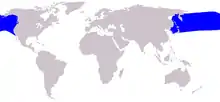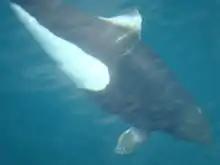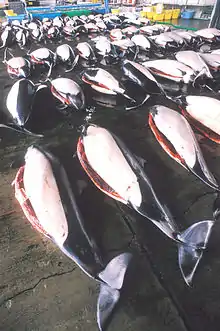Dall's porpoise
Dall's porpoise (Phocoenoides dalli) is a species of porpoise endemic to the North Pacific. It is the largest of porpoises and the only member of the genus Phocoenoides. The species is named after American naturalist W. H. Dall.
_BHL45850430.jpg.webp)
| Dall's porpoise[1] | |
|---|---|
.jpg.webp) | |
 | |
| Size compared to an average human | |
| Scientific classification | |
| Kingdom: | Animalia |
| Phylum: | Chordata |
| Class: | Mammalia |
| Order: | Artiodactyla |
| Infraorder: | Cetacea |
| Family: | Phocoenidae |
| Genus: | Phocoenoides (Andrews, 1911) |
| Species: | P. dalli |
| Binomial name | |
| Phocoenoides dalli (True, 1885) | |
 | |
| Dall's porpoise range | |
Taxonomy
Dall’s porpoise is the only member of the genus Phocoenoides. The dalli- and truei-types were initially described as separate species in 1911, but later studies determined that the available evidence only supported the existence of one species.[3][4] Currently, these two color morphs are recognized as distinct subspecies, Dall's porpoise (Phocoenoides dalli dalli) and True's porpoise (Phocoenoides dalli truei).[2]
Description

Dall's porpoises can be easily distinguished from other porpoises and cetacean species within their range. They have a wide, robust body, a comparatively tiny head, and no distinguished beak. Their flippers are positioned at the front of the body and a triangular dorsal fin sits mid-body. Patterns of coloration are highly variable, but Dall’s porpoises are mostly black, have white to grey patches on the flank and belly, and frosting on the dorsal fin and trailing-edge of the fluke.[5][6]
They are the largest porpoise species, growing up to 7.5 ft (2.3 m) in length and weighing between 370 and 490 lbs (130 and 220 kg).[6] Sexual dimorphism is apparent in body size and shape, with mature males being larger, developing a deeper caudal peduncle, and having a dorsal fin that’s significantly angled forward in comparison to a female’s.[5] Dall’s porpoise calves have a greyish coloration with no frosting on flippers and flukes. Calves measure about 100 cm at birth.[7] Growth rates are similar at first, but at about 2 years old males begin to grow faster than females.[7] Externally, maturity is measured by length which is usually attained at 3 – 5 years old.[8] Sizes vary between populations, but on average females reach a maximum size of 210 cm and males grow to about 220 cm, except in the southern Okhotsk Sea where males can grow as long as 239 cm.[7]
Two colormorphs have been identified: the dalli-type and truei-type. The truei-type, found only in the western Pacific, has a white belly patch that extends farther forward across the body than that of the dalli-type.[5][3][9]
Distribution and habitat

Dall’s porpoises are limited to the North Pacific: in the east from California to the Bering Sea and Okhotsk Sea, and in the west down to the Sea of Japan.[10] They have been sighted as far south as Scammon’s Lagoon in Baja California when water temperature was unseasonably cold.[10]
Dall’s porpoises generally prefer cold waters less than 64 °F (18 °C).[6] Although mostly an offshore species, they do occur in deeper coastal waters, near submarine canyons or in fjords.[6][10]
Behavior

Foraging
Dall’s porpoises are opportunistic, hunting a variety of surface and mid-water species. Common prey are mesopelgic fish, such as myctophids, and gonatid squid.[5][10][2] Stomach content analyses have also found cases of crustacean consumption, including krill and shrimp, but this is abnormal and likely not an important part of their diet.[10] A previous study revealed that tagged Dall’s porpoises spent most of their time within 10 m of the surface,[11] but have been recorded diving to depths of up to 94 m.[12]
Social
Dall's porpoises live in small, fluid groups of 2 – 10 individuals,[6] but aggregations of hundreds have been reported.[10] They have a polygynous mating system in which males compete for females.[13] During the mating season, a male will select a fertile female and guard her to ensure paternity.[13] While guarding, males may sacrifice opportunities to forage on deep dives.[13] Births usually take place in the summer after a gestation period of 11 – 12 months.[10] Females generally give birth every 3 years, depending on their condition.[6] Life expectancy is about 15 – 20 years, but a lot about their mortality is unknown.[14]
Dall’s porpoises are prey to transient killer whales.[15] They have, however, been observed in association with resident killer whales, engaging in apparent play behaviors with their calves, and swimming with them.[16] One recognizable Dall’s porpoise was observed travelling with the AB pod of resident orca from May through October 1984.[16]
Movement

Dall’s porpoises are highly active swimmers. Rapid swimming at the surface creates a characteristic spray called a "rooster tail". They are commonly seen approaching boats to bowride, and they will also ride on the waves formed at the heads of larger swimming whales.[6][10]
Population status
Abundance throughout their range and is estimated to be over 1 million, but current population trends are unknown.[2]
Surveys along the coasts of California, Oregon, and Washington between 2008 and 2014 estimated a population abundance of 25,800.[17][18] Alaska’s population is estimated to be 83,400.[19][20] Abundance in coastal British Columbia is nearly 5,000 individuals.[21]
Populations in the western North Pacific are divided by both subspecies and migratory patterns. Abundance of the offshore dalli-type is about 162,000.[22] It is estimated that there are about 173,000 dalli-type that travel between Japan and the southern Okhotsk Sea.[22][23] The dalli-type that migrates to the Okhotsk Sea in the summer is estimated at 111,000.[23] The population of truei-type porpoises migrating between Japan and the central Okhotsk Sea number about 178,000.[22]
Threats
Fisheries bycatch
Dall’s porpoises are vulnerable to fisheries bycatch. Thousands were killed in commercial driftnet fisheries until the United Nations issued a moratorium in the 1990s.[2][24] Before the moratorium went into effect, 8,000 Dall’s porpoises are estimated to have been bycaught in one year alone (1989-1990).[25] Smaller numbers, from several hundred to a few thousand, are estimated to have been bycaught in Japanese salmon fisheries in US waters and in the Bering Sea from 1981 to 1987.[26] Driftnet and trawl fisheries still operate in some areas throughout their range,[2] with particularly high levels of bycatch in Russian waters.[27]
Hunting

The Dall's porpoise is still harvested for meat in Japan. The number of individuals taken each year increased following the 1980s moratorium on whaling of larger cetacean species.[28] In 1988, more than 45,000 Dall’s porpoises were harpooned.[28] In 1990, after international attention was drawn to the issue, the Japanese government introduced a reduction on take. A quota of over 17,000 a year is in effect today (9,000 dalli-type in the Japan-southern Okhotsk Sea population; 8,700 from the truei-type population that migrates into the central Okhotsk Sea)[2] making it the largest direct hunt of any cetacean species in the world.[29] The hunt of Dall’s porpoises has been criticized by scientific committees which question the sustainability of large quotas on regional populations.[30][31] Assessments are outdated for these targeted populations, and given the level of annual reported take, there may be regional declines in abundance.[28][22]
Pollution
Environmental contaminants, including dichlorodiphenyldichloroethylene (DDE) and polychlorinated biphenyls (PCBs), are another threat to Dall’s porpoises. Pollutants accumulate in the blubber layer, and in high concentrations can reduce hormone levels, affect the reproductive system,[32] and result in calf death.[33]
Conservation status
Dall’s porpoise is listed as Least Concern on the IUCN Red List.[2] Levels of both bycatch and commercial hunting are likely underestimates because they account only for reported data; however, there is no evidence for a range-wide decline of the species.[2]
The species is also listed on Appendix II[34] of the Convention on the Conservation of Migratory Species of Wild Animals (CMS), and, like all other marine mammal species, is protected in the United States under the Marine Mammal Protection Act (MMPA).[35]
References
- Mead, J.G.; Brownell, R. L. Jr. (2005). "Order Cetacea". In Wilson, D.E.; Reeder, D.M (eds.). Mammal Species of the World: A Taxonomic and Geographic Reference (3rd ed.). Johns Hopkins University Press. pp. 723–743. ISBN 978-0-8018-8221-0. OCLC 62265494.
- Jefferson, TA; Braulik, G. "Phocoenoides dalli". The IUCN Red List of Threatened Species 2018.
- Morejohn, GV (1979). The Natural History of Dall's Porpoise in the North Pacific Ocean. In: Winn HE, Olla BL (eds) Behavior of Marine Animals. Boston, MA: Springer. pp. 45–83. ISBN 978-1-4684-2985-5.
- Benson, SB; Groody, TC (1942). "Notes on the Dall's porpoise (Phocoenoides dalli)". Journal of Mammalogy. 23 (1): 41–51. doi:10.2307/1374854. JSTOR 1374854.
- Jefferson, TA (1989). "Sexual dimorphism and development of external features in Dall's porpoise (Phocoenoides dalli)". Master's Theses. 3149. doi:10.31979/etd.9b8a-t74q.
- Stewart, BS; Clapham, PJ; Powell, JA; Reeves, RR (2002). National Audubon Society Guide to Marine Mammals of the World (2nd ed.). Alfred A. Knopf. p. 470–473. ISBN 978-0-375-41141-0.
- Houck, WJ; Jefferson, TA (1999). Dall's Porpoise (Poceonoides dalli). In: Ridgeway SH, Harrison R (eds) Handbook of Marine Mammals Volume 9 (1st ed.). San Diego, CA: Academic Press. pp. 443–473. ISBN 9780125885065.
- Ferrero, RC; Walker, WA (1999). "Age, growth, and reproductive patterns of Dall's porpoises (Phocoenoides dalli) in the central North Pacific Ocean". Marine Mammal Science. 15 (2): 273–313. doi:10.1111/j.1748-7692.1999.tb00803.x.
- Amano, M; Miyazaki, N (1996). "Geographic variation in external morphology of Dall's porpoise, Phocoenoides dalli". Aquatic Mammals. 22 (3): 167–174.
- Jefferson, TA (2008). Dall's porpoise Phocoenoides dalli. In: Würsig B, Perrin W, Thewissen JGM (eds) Encyclopedia of Marine Mammals (2nd ed.). Academic Press. pp. 296–298. ISBN 9780080919935.
- Baird, RW; Hanson, MB (1998). "A preliminary analysis of the diving behavior of Dall's porpoise in the transboundary waters of British Columbia and Washington. In: Marine Mammal Protection Act and Endangered Species Act Implementation Program 1997". Alaska Fisheries Science Center Processed Report No. 98-10, Alaska Fisheries Science Center, National Marine Fisheries Service, Seattle, WA: 99–110.
- Hanson, MB; Baird, RW (1998). "Dall's porpoise reactions to tagging attempts using a remotely-deployed suction-cup attached tag" (PDF). Marine Technology Society Journal. 32 (2): 18–23.
- Willis, PM; Dill, LM (2007). "Mate guarding in male Dall's porpoises (Phocoenoides dalli)". Ethology. 113 (6): 587–597. doi:10.1111/j.1439-0310.2007.01347.x.
- "Dall's Porpoise". NOAA Fisheries. 27 June 2019.
- Deecke, VB; Ford, JKB; Slater, PJB (2005). "The vocal behaviour of mammal-eating killer whales: communicating with costly calls". Animal Behaviour. 69 (2): 395–405. doi:10.1016/j.anbehav.2004.04.014.
- Saulitis, E; Matkin, C; Barrett-Lennard, L; Heise, K; Ellis, G (2000). "Foraging strategies of sympatric killer whales (Orcinus orca) populations in Prince William Sound, Alaska". Marine Mammal Science. 16 (1): 94–109. doi:10.1111/j.1748-7692.2000.tb00906.x.
- Caretta, JV; Forney, KA; Muto, MM; Barlow, J; Baker, J; Hanson, J; Lowry, MS (2006). "U.S.Pacific marine mammal stock assessments: 2005". NOAA Technical Memorandum NMFS-SWFSC-388.
- Barlow, J (2016). "Cetacean abundance in the California current estimated from ship-based line transect surveys in 1991-2014". NOAA Southwest Fisheries Science Center Administrative Report LJ-2016-01.
- Angliss, RP; Outlaw, RB (2005). "Alaska marine mammal stock assessments". NOAA Technical Memorandum NMFS-AFSC.
- Muto, M; Helker, VT; Angliss, RP; Allen, BA; Boveng, PL; Breiwick, JM; Cameron, MF; Clapham, P; Dahle, SP; Dahlheim, ME; Fadley, BS (2017). "Alaska marine mammal stock assessments, 2016". NOAA Technical Memorandum NMFS-AFSC-355.
- Williams, R; Thomas, L (2007). "Distribution and abundance of marine mammals in the coastal waters of British Columbia, Canada". Journal of Cetacean Research and Management. 9: 15–28.
- Kasuya, T (2017). Small Cetaceans of Japan: Exploitation and Biology. CRC Press. ISBN 9781498779005.
- International Whaling Commission (1998). "Report of the scientific committee". Report of the International Whaling Commission. 48: 53–302.
- Reeves, RR; Smith, BD; Crespo, EA; Notarbartolo di Sciara, G (2003). "Dolphins, Whales and Porpoises: 2002-2010 2002-2010 Conservation Action Plan for the World's Cetaceans". IUCN, Gland, Switzerland and Cambridge, UK.
- Hobbs, RC; Jones, LL (1993). "Impacts of high seas driftnet fisheries on marine mammal populations in the North Pacific". International North Pacific Fisheries Commission Bulletin. 53 (3): 409–434.
- International Whaling Commission (1991). "Report of the scientific committee". Report of the International Whaling Commission. 41: 51–219.
- Burkanov, VN; Nikulin, VS (2001). "By-catch of the marine mammals at the Japanese fishing in the Russian Exclusive Economic Zone of the Bering Sea". Rybnoye Khozioaystvo-Moskva (Partnership LTD. Journal). 5: 32.
- Kasuya, T (2007). "Japanese whaling and other cetacean fisheries" (PDF). Environmental Science and Pollution Research. 14 (1): 39–48. doi:10.1065/espr2006.09.346.
- "Phocoenoides dalli (Dall's porpoise, Dall porpoise)". The Society for Marine Mammalogy.
- "Report of the Sub-Committee on Small Cetaceans". International Whaling Commission. 2008.
- Wells, RS. "Letter to Japanese Government Regarding Dolphin and Small Whale Hunts". The Society for Marine Mammalogy.
- Subramanian, A; Tatsukawa, R; Saito, S; Miyazaki, N (1987). "Reduction on the testosterone levels by PCBs and DDE in Dall's porpoises of northwestern North Pacific". Marine Pollution Bulletin. 18 (12): 643–646. doi:10.1016/0025-326X(87)90397-3.
- Vos, JG; Bossart, GD; Fournier, M; O'Shea, TJ (2003). Toxicology of Marine Mammals. New York, NY: Taylor and Francis. ISBN 0-203-26010-4.
- "Appendix II of the Convention on the Conservation of Migratory Species of Wild Animals (CMS). As amended by the Conference of the Parties in 1985, 1988, 1991, 1994, 1997, 1999, 2002, 2005 and 2008. Effective: 5 March 2009" (PDF). CMS.
- U.S. Fish and Wildlife Service. "Marine Mammal Protection Act". International Affairs.
External links
To learn more about the Dall's porpoise and other cetacean species visit:
| Wikimedia Commons has media related to Phocoenoides dalli. |

